“Cradle of Indian Temple architecture at Aihole” – sounds strange? Wondering if there’s really a “cradle” of the temple architecture in India? Where the varied, beautiful and mind-blowing temples of India drive their inspirations from? Yes, there is one such place. Located in the center of North Karnataka – in the cultural circuit of Badami – Pattadakal – Aihole.
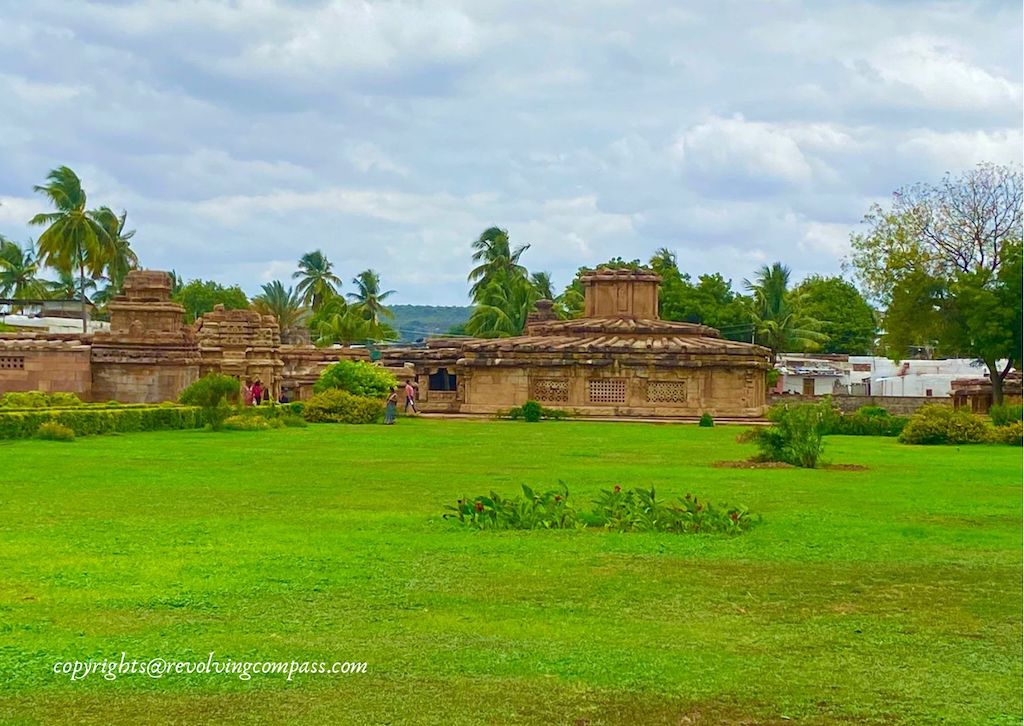
So, if ever you have stood in front of some of the most beautiful ancient temples in India. From the ancient Baijnath Temple that we visited on our tour to Palampur in the Himalayas. To the Ranakpur Jain Temple in west India whose architectural details will blow you away. And the one of it’s kind world famous Khajuraho Temple Complex in central India, the Kashi Vishwanath Temple in Banaras on the ghats of Ganga to the temple which doesn’t cast a shadow – the Brihadeeshwara Temple in Tanjavur district of Tamil Nadu. To the Temple Complex of Halebidu and Badami which had so much details that one trip fell short to cover it all!! And wondered – how and where did the artisans learnt such great magnificent architectural details. Then you have arrived at the answer – Aihole !! This is the place where it all started and originated.
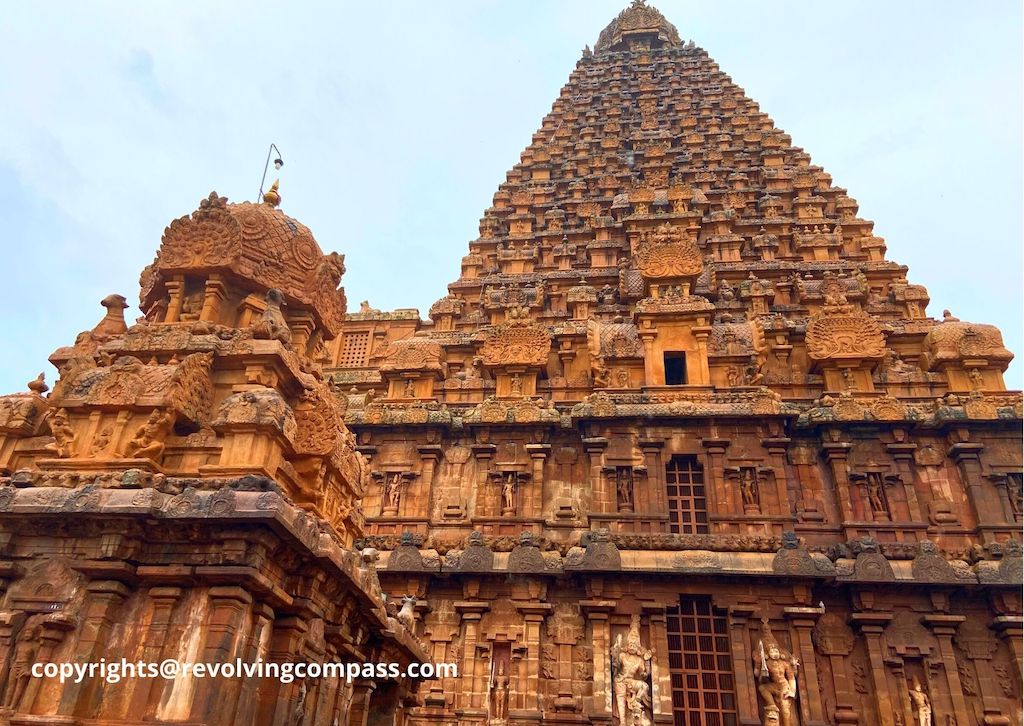
No wonder Aihole is fondly known as the cradle of Indian Temple Art of India. It is here that the prototypes of several temples were developed. Don’t be stunned when you see prototypes of temples like the Khajuraho Temple, The Kashi Vishwanath Temple or the Virupaksha Temple here !! Because this is where the artisans worked day and night, polishing their skills. And when the skills were refined enough, they moved to different parts of the country to build the magnificent temples. The mind blowing Nagara and Dravidian form of temple architectures find their origin here. And what’s even more stunning is to comprehend that there are temples in Aihole that date back to 7th century CE !! Thats how far rooted is the temple architecture of India !!
Table of Contents
History of Aihole & the cradle of Indian Temple architecture at Aihole
The name “Aihole”
Aihole is located in the valley of the river Malaprabha. And it was earlier known as “Aryapura”. There is an interesting story in the Indian mythologies about the naming of Aihole. Lord Parshuram an avataras of Vishnu, washed his axe in the river Malaprabha after avenging his father. This turned the river red. And a lady witnessed the red water flowing down the hills, and exclaimed – “Aiyyo hole”. Which translated to English, means “Oh! blood”. And that is how it came to be known as “Aihole” !!
The story about the rise of the cradle of Indian Temple Architecture at Aihole
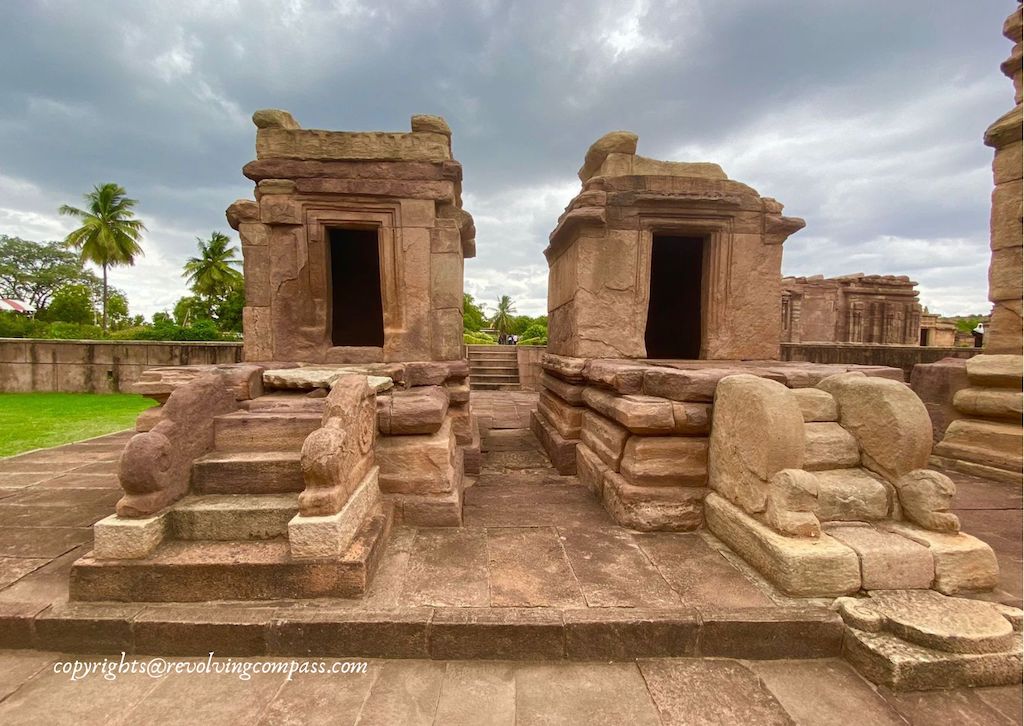
It was in the times of the Chalukya dynasty that the cradle of Indian temple Architecture at Aihole took shape. Artists here practiced their skills. And in the process built several temple prototypes. Both north and south Indian temple architectural styles developed here. Some of the major features of temple architecture that developed in this era included –
- Naggara Style of North Indian temple architecture
- Dravidian Style of South Indian temple architecture
- Creating temples out of interlocking and balancing stone blocks without using mortar
- Flat roofs
- Rich carvings and intricate designs which included floral, deities, mythological stories, Purana stories etc.
Hindu, Buddhist as well as Jain temples were developed here. And when the artists perfected the art, they moved to Badami where they worked on bigger temples – the ones that form the Badami Cave Temples and the Bhoothnatha Temple and other temples in Badami.
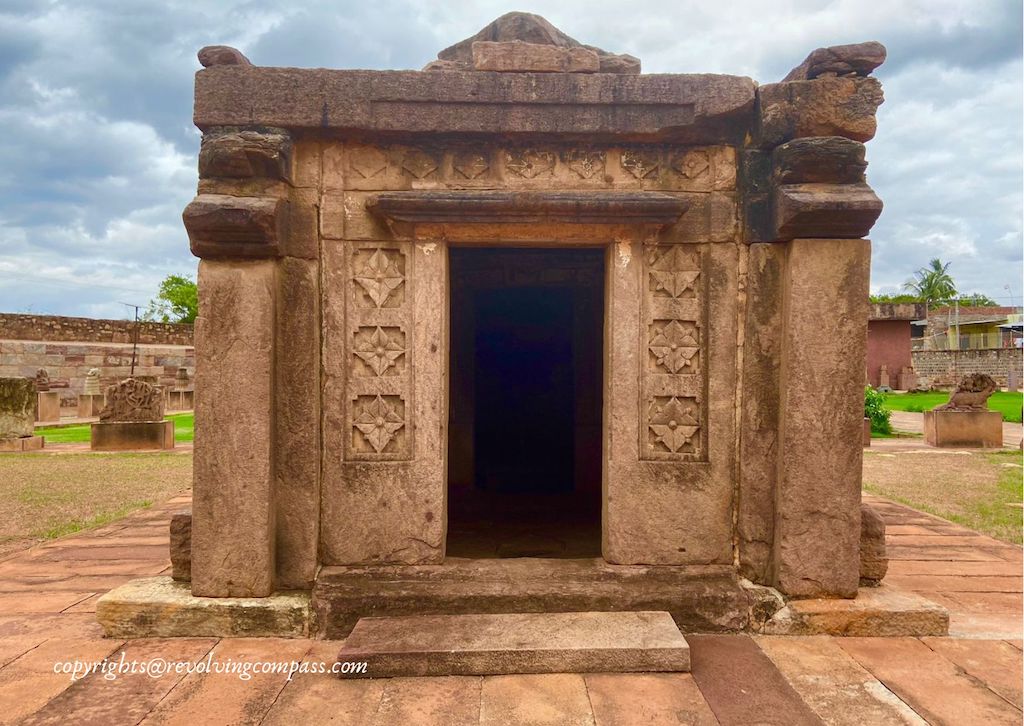
The most perfect artists then moved further to Badami, carving out what is known as the famous Pattadakal Group of Temples – a pride UNESCO World Heritage Site of India. And then during the Vijayanagara Empire reign, many of them moved to Hampi, creating the masterpieces of architecture at the UNESCO World Heritage site of Hampi.
The destruction of the Aihole temples
Although post the 13th Century, muslim invaders destroyed many temples. And the area of Aihole was altogether neglected during the British Empire rule. Finally, in the 20th century, the architectural significance of the Aihole was established once again. The cradle of Indian Temple architecture at Aihole then started getting attention once again. With restoration done at several places. Excavations and efforts of the government. Today, it forms one of the most important trails on the North Karnataka Heritage tour. With over 120 temples still lying in this area !!
A virtual tour through the cradle of Indian Temple Architecture at Aihole
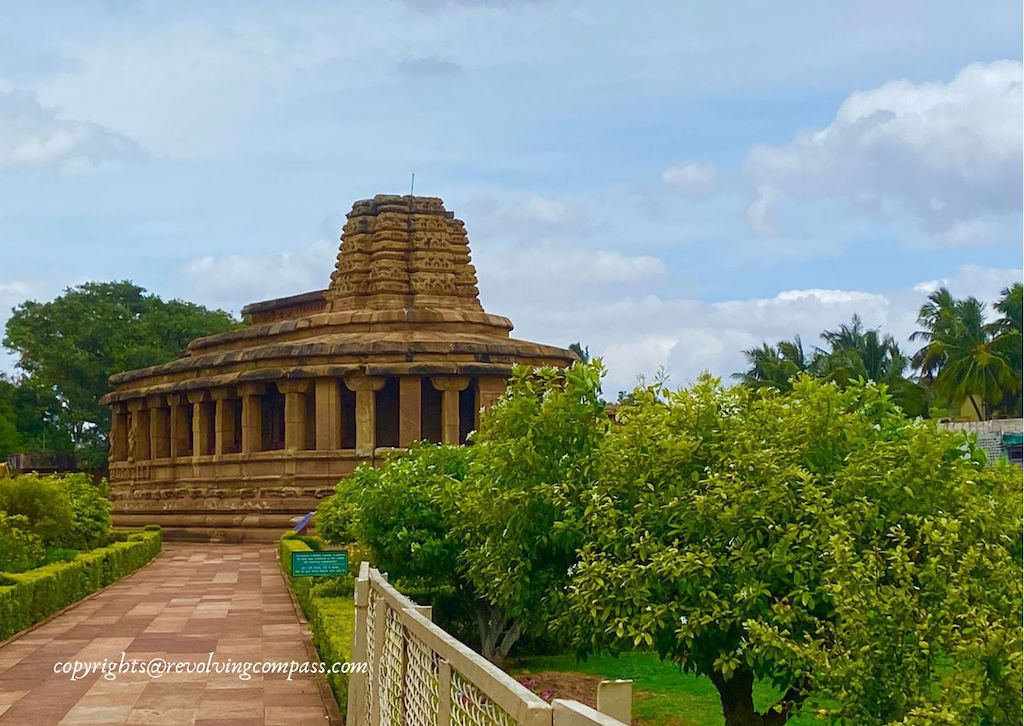
Although there are 120 plus temples in the Aihole cluster of temples. But the major one is the Durga Temple Complex. There is a ticket counter at the entry. That also has a lot of information on the history of this Temple complex and its temples. The major temple complexes in this area include the following temple complexes:
Aihole temple complexes
There are 15+ temple complexes within Aihole. Feels overwhelming, isn’t it? Well, after all it is cradle of Indian Temple architecture at Aihole that we are exploring! The spread of temple complexes here reminded me strongly of the temple complex at Khajuraho. Where the Southern and Western Group of Temples are located in one complex whereas the eastern group of temples are scattered across the region in no particular order.
Also, the vast expanse of these temple complexes reminded me strongly of the Sukhothai National Park that we explored on our trip to Thailand. Only if we had bicycles on rent and electric cars to roam around here like there are in Sukhothai! Anyways, here I have tried to bring some order to visiting these complexes through this map. To name a few of these complexes, they are –
- Sri Durga Temple Complex
- Ambigergudi temple Complex, opposite Sri Durga Temple Complex
- Sri Galaganatha Temple Complex
- Ramalingeshwara Temple Complex
- Joyotirlinga Group of temples
- Hucchimalli Gudi
- Ravana Phadi
- Mallikarjuna Gudi
- Meguti Jaina Basadi.
However, to cover all these temple complexes inside cradle of Indian Temple architecture at Aihole, you will need to dedicate one complete day to Aihole. So, I suggest you start with the Durga Temple Complex. This temple complex has a cluster of major temples. And in the same complex lies the Aihole Archeological Museum and a step well. On our trip to Aihole, we also explored the Durga Temple Complex mainly. And stopped for a quick glimpse at some of the other temple complexes.
Here’s a map elaborating the Durga Temple Complex at Aihole.
Durga Temple Complex at the cradle of Indian Temple architecture at Aihole
The main temple complex of Aihole is Durga Temple. It consists of 12 Hindu Temples, all constructed around 6th to 8th century.
Once you park your vehicle and buy tickets to the Durga Temple Complex. you can visit these temples and other important sites in the order of the above map.
Entry ticket to Durga Temple complex is INR 25 per adult at the time of this writing. Children below 12 years have free entry.
Durga Temple
Ironically, the Durga Temple in Aihole is not the one dedicated to Goddess Durga. Instead, the name “Durga” refers to “Durg” – a fort complex. As, it is believed that this temple was also used as a lookout place by Marathas, thus serving the purpose of a fort. Just like most of the other Dravidian temples of the region, the Durga Temple also has an outer chamber called “Mukhamandapa” and an inner sanctum called a “Garbhagriha”. The walls and ceilings of the temple are intricately carved with fine sculptures of Hindu Gods like Vishu, Shiva, Durga and many more. The carvings of these temples closely resemble those of Brihadeeshwara Temple of Tanjore and Hoysaleshwara Temple of Halebidu.
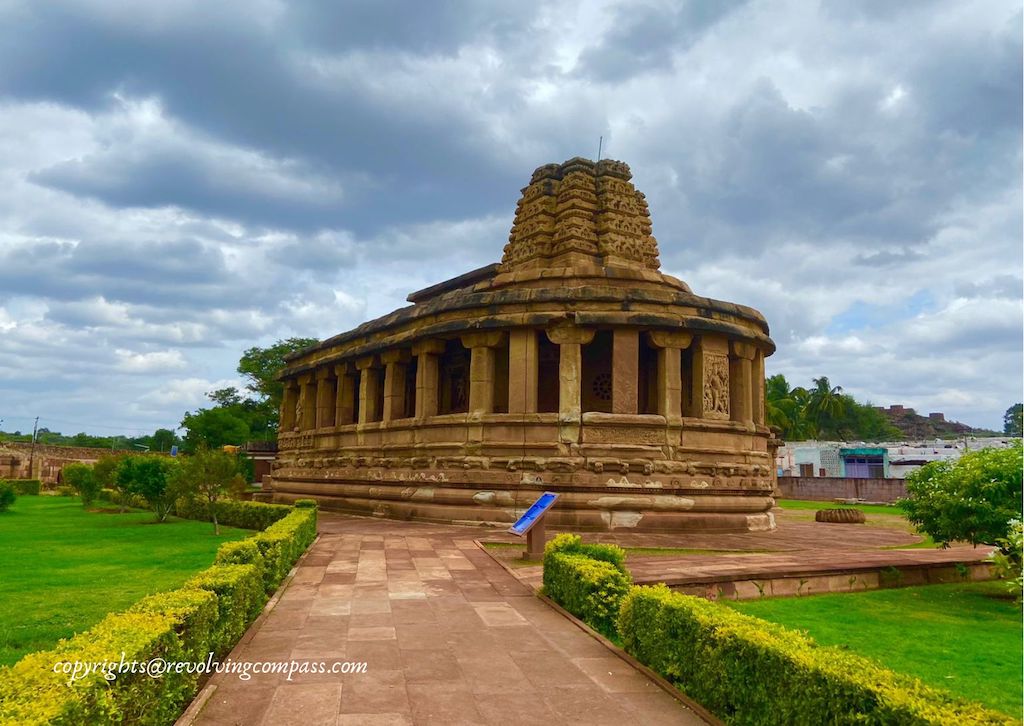
In the inner sanctum, a Nandi faces the main linga. This is a unique among all the temples of Aihole. As this Durga temple also has a small Pushkarni of it’s own where one can wash themselves or take a dip before entering the temple. Unfortunately the water doesn’t seem to be clean anymore and entry to the steps leading to the water is closed.
Durga Temple is one of the most elaborate temples of this complex of Aihole. Perhaps thats why the temple complex itself is named after it.
Sri Lad Khan Temple
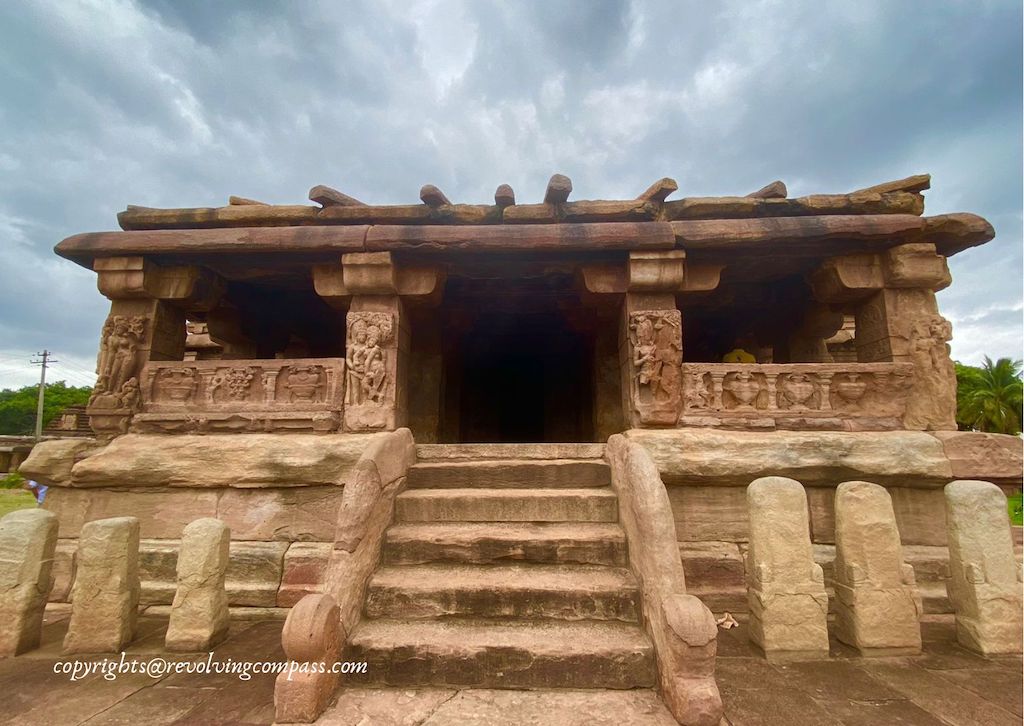
I was surprised to find a temple with the name “Khan” in it. I guess this is the only temple in whole India named after a muslim! The name originated from that of LadKhan – who used this temple as his residence before it came under ASI. The LadKhan Temple is dedicated to Lord Shiva. It is built in three concentric squares. The outer part is the Sabhamandapa or Mukhmandapa (the assembly hall or community hall) whose tall pillars are carved in intricate floral patterns. Also you can spot the emblem of Chalukya– the Varaha – here. Some of the carvings on this temple are even erotic. Is it possible that they served as the prototype or inspiration for the temples in the Khajuraho Temple Complex ? Sadly I couldn’t get any link here.
At the center of the Mukhmandapa, again there is a large Nandi, facing the main shrine where the Shiva Linga lies. Also, this temple is built in a North Indian Nagara style.
Chappara Temple
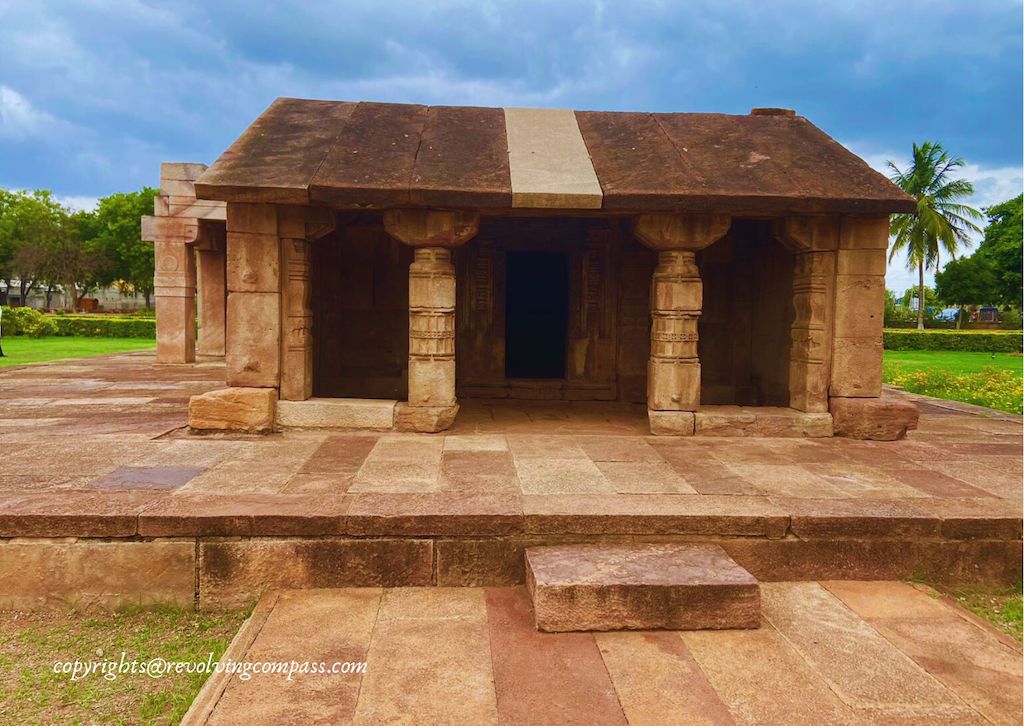
Literally, “Chappara” means “thatched roof” – the kind made with natural materials like “phoos” or “khappad” which is seen in rural houses of India. And “Gudi” means temple. So, most likely, this temple gets its name pertaining to it’s architecture that consists of tall pillars supporting the flat roof. As you inside this temple, you will get the feeling of rather standing inside a courtyard, supported by tall heavy carved pillars. For a while, it transported me to the temple of Avani near Bangalore.
Suryanarayanagudi Temple
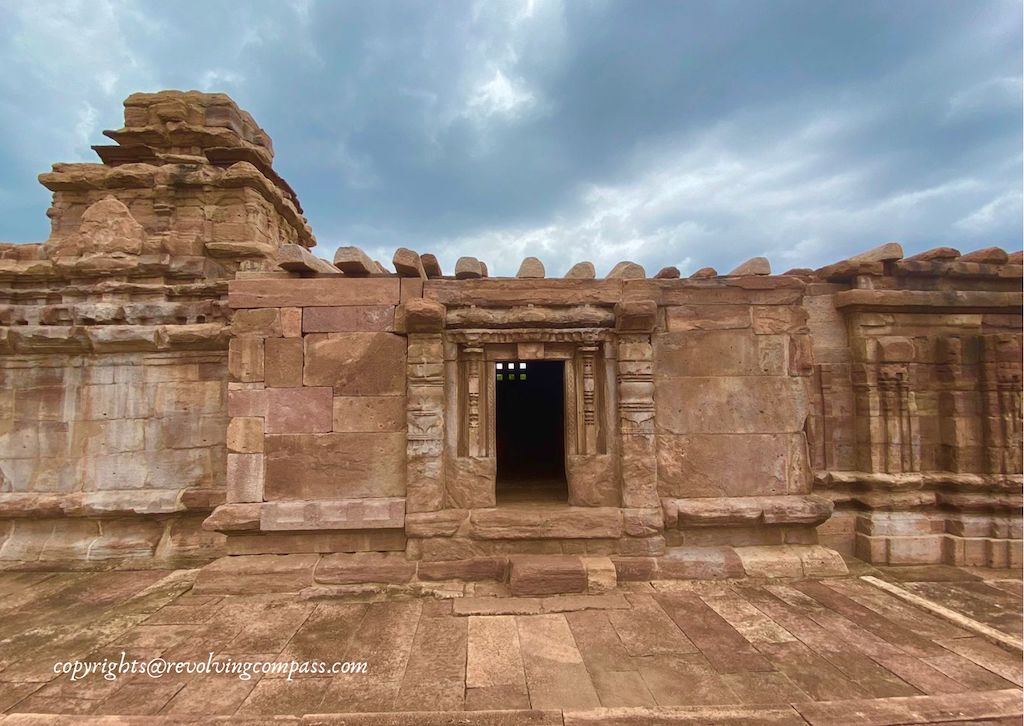
The Suryanarayanagudi Temple is a simple temple in the Durga Temple Complex in Aihole. It has a small statue of Lord Surya inside the temple, along with Ganga and Yamuna on both sides of the main idol. The statue is lit by sunlight. But mostly the rest of the temple is dark. Again, reminds of the similarities to the Khajuraho Group of Temples where mostly the inner sanctum of the temples are dark, except for the morning sunlight lighting the main idols.
Gaudara Gudi Temple
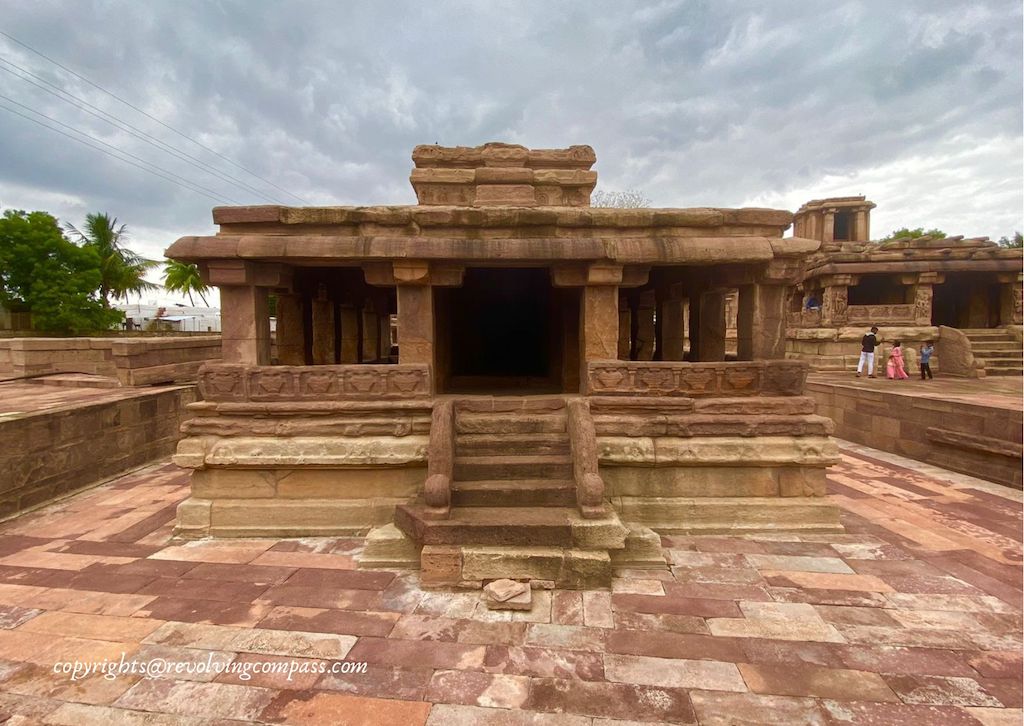
A huge temple courtyard with almost flat roof stands right besides Lad Khan Temple. That is the Gaudara Gudi Temple. It reminded me of the Ramalingeshwara Group of Temples from Avani. This temple is dedicated to Goddess Parvati. And is believed to be one of the oldest temples in the Durga Temple complex.
Chandragudi Temple
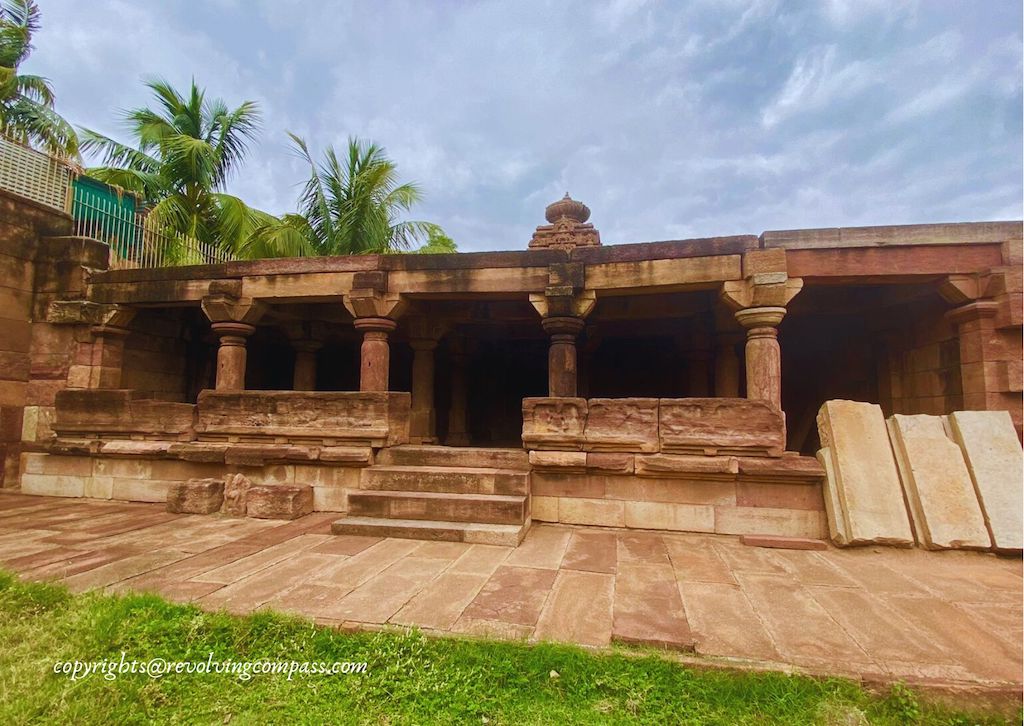
Chandraguri Temple was constructed in the 9th century. It is famous for it’s 20 sculptures of enormous couples engraved on the doorframe of the sanctum. The sanctum also has a Gaduda holding two snakes on the lintel. The temple has a sanctum and a rangamandapa. And the shikhara on the garbhagriha is of Nagara Style.
Badiger Gudi
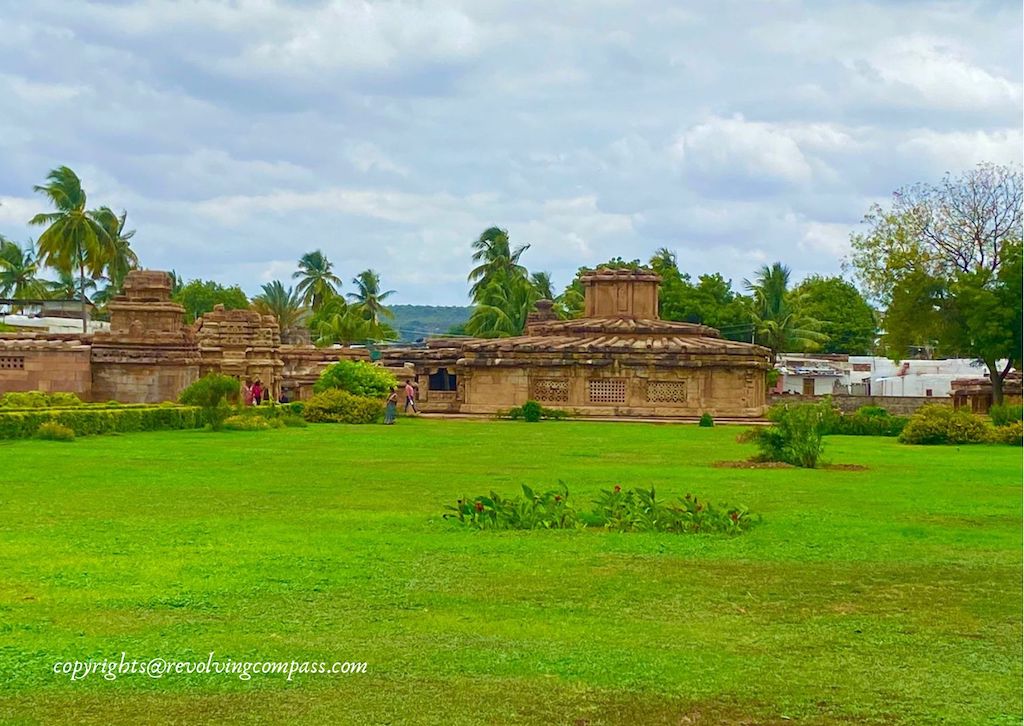
Besides the step well between Chakra Gudi Temple and Gaudara Gudi temple lies the Badiger Gudi. This temple is a small one, with flat roof of the outer chamber and a dome over the inner chamber. The literal meaning of the name of this temple is “Carpenter’s Temple”. Interestingly, as per the stories, a carpenter and his family lived here. So, it was named after them.
Nadyar Gudi
As you complete the circle and come back near the Durga Temple, you get to see Nadyar Gudi. Although most of the temple is in ruins. But the huge pillars that remain will immediately remind you of the Chennakeshava Temple of Belur and the Hoysaleshwara Temple of Halebidu.
There are many other small temples in this complex, whose name couldn’t be identified. But they are all very pretty and attractive with their detailed constructs. So, you can just visit them in passing while hopping between the other major temples. Some of the temples that we saw included these:
Aihole Archeological Museum
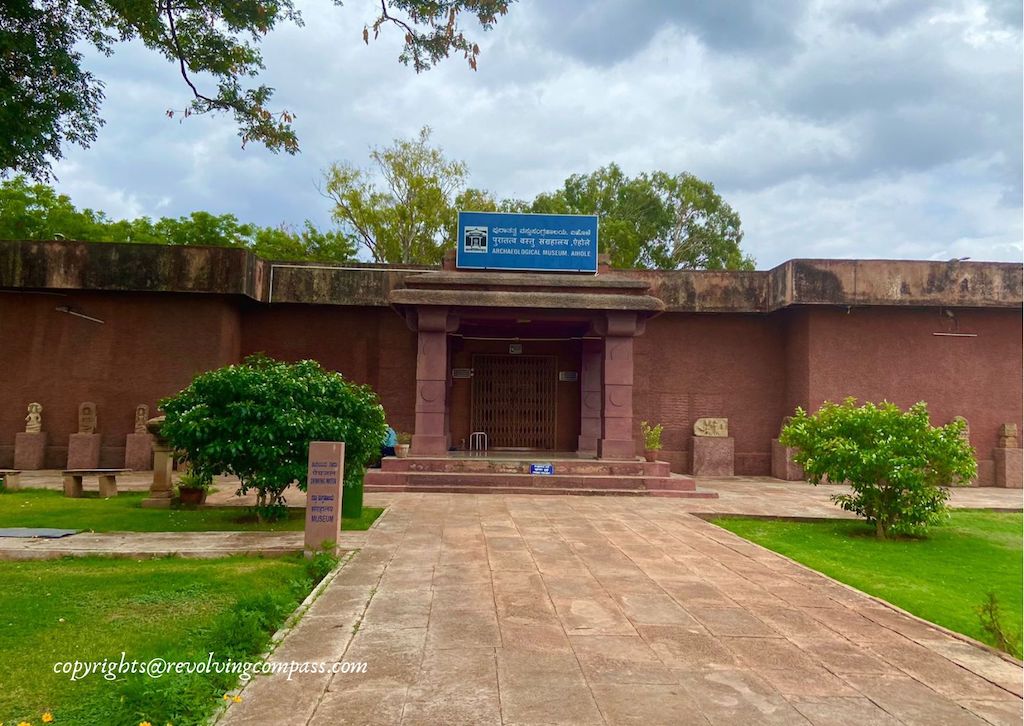
Right near the Durga Temple inside the Durga Temple Complex lies the Aihole Archeological Museum. This museum consists of bits and pieces of the carvings and parts of ruined temples that were discovered during excavation. However, we visited here on a friday. And this museum is closed on Fridays. So, I couldn’t go inside. But, right outside the museum, there are stone carvings with intricate details. That were perhaps at some point of time part of either the temples or excavated from this area. They stand on 3 sides of the museum as if forming a boundary wall to it. And they are each so beautiful and rich in their own way that you simply can’t tear your eyes from them!! Look at some of the below pieces to understand what I mean:
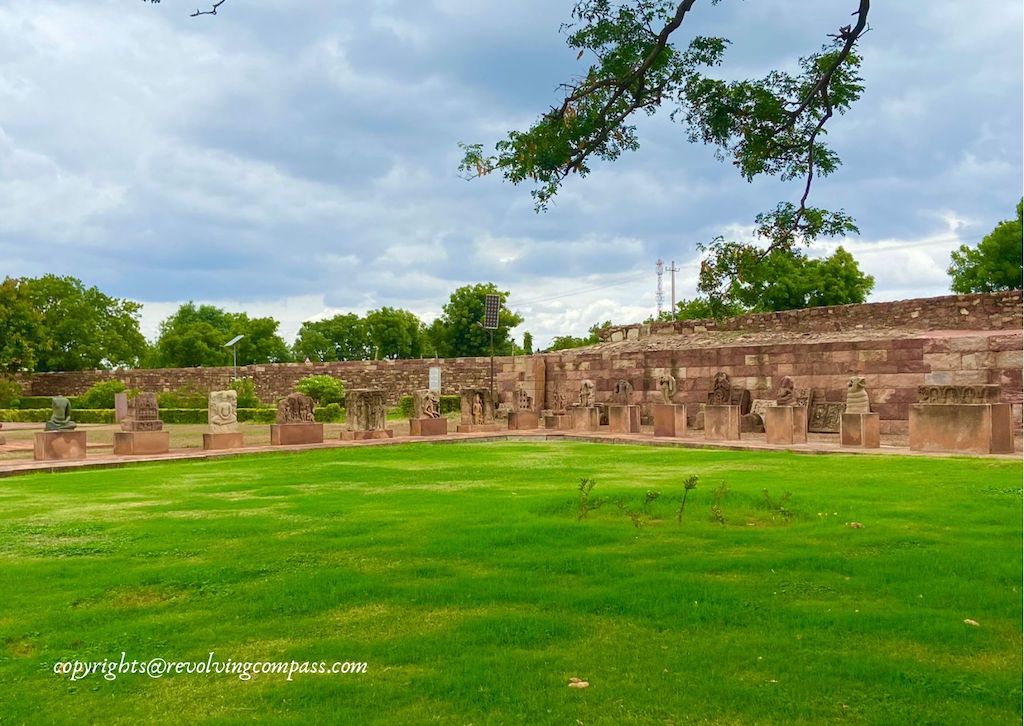
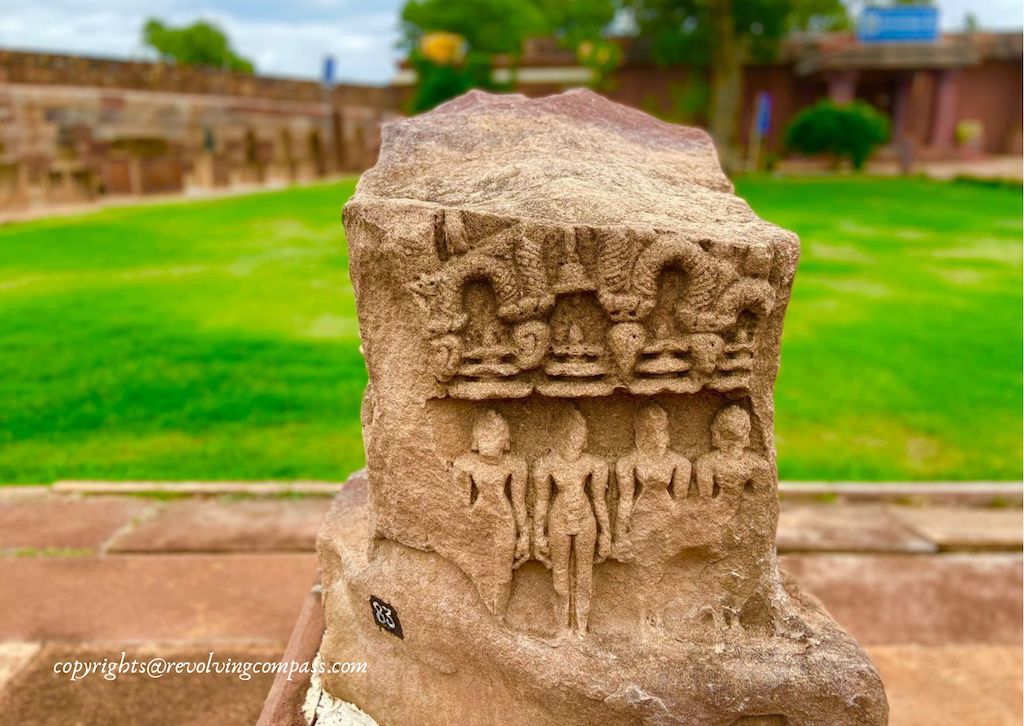
Devalaya Pushkarni
It is the Pushkarni or the step well that lies in the Durga Temple Complex. In fact, there are two step wells here. One is a part of the Durga Temple itself. While the second one is a much larger one near Chakra Gudi. It has a very symmetrical structure and carvings on the inner walls. I am sure now after seeing this step well that the famous step wells of Rajasthan and Gujarat are definitely inspired from here. And this is where the tradition of having Pushkarnis around Dravidian temples must have started.
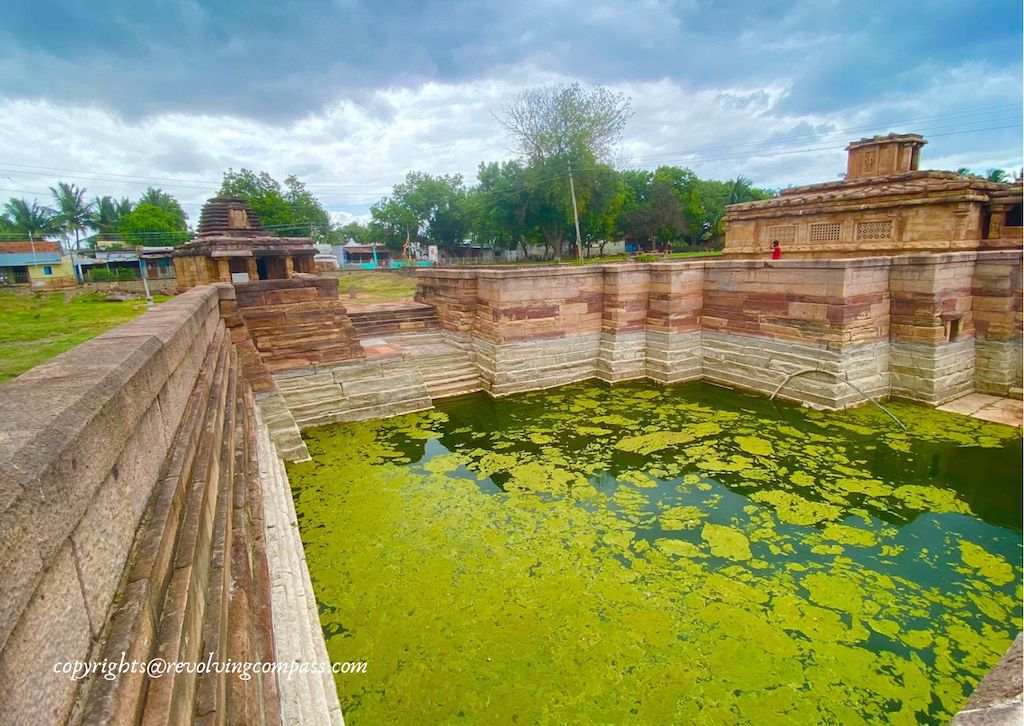
Exploring other temple Complexes at the cradle of Indian Temple architecture at Aihole
To be honest, it is not really possible to cover all of the temple complexes at the cradle of Indian Temple Architecture at Aihole in one single day. You can simple glimpse through them. Or, maybe skip some like us. As we did a day trip to Aihole and Pattadakal from Badami in one single day. Nevertheless, here’s a mention of some more of the temples that I learnt. We spotted some of these and had to skip some due to time constraint.
If you are a student or enthusiast of architecture, particularly Indian temple architecture. Then I will highly recommend you to at least reserve two days for Aihole alone. Each of these temples have a lot of details to be captured, understood and admired. For which we really need a lot of time at hand. I wish to make another trip to this place in future when I can thoroughly cover all the other temples.
Sri Veerbhadreshwara Gudi
A temple of Veerbhadreshwara, this temple might have served as a prototype of the main Veerbhadeshwara Temple in Hampi. However, I couldn’t find much similarity between this temple and the main temple in Hampi. If you do, please do let me know.
Konti gudi Complex
One of the few temples that faces west is Konti Gudi or Konti Temple. It is built around the 7th century CE. Originally built as a simple structure with 4 walls on all sides, it was then glorified over the years. With more constructions around the main temple. The garbhagriha is located towards the back wall of the temple. And there is a slightly elevated shikara over the otherwise flat roof of the temple.
Twin Jain Temples Complex
This one consists of two simple Jain Temples. They will remind one of the Ratha Temple of Mahabaleshwar.
Ambigergudi Temple Complex
Right across from the Durga Temple Complex lies the Ambigergudi Temple Complex.This temple complex has 3 temples inside its campus. Dedicated to Lord Shiva and Lord Surya. But unfortunately, most of the structures are in ruins now. I just took some snaps of this complex and the temple visible from the main road.
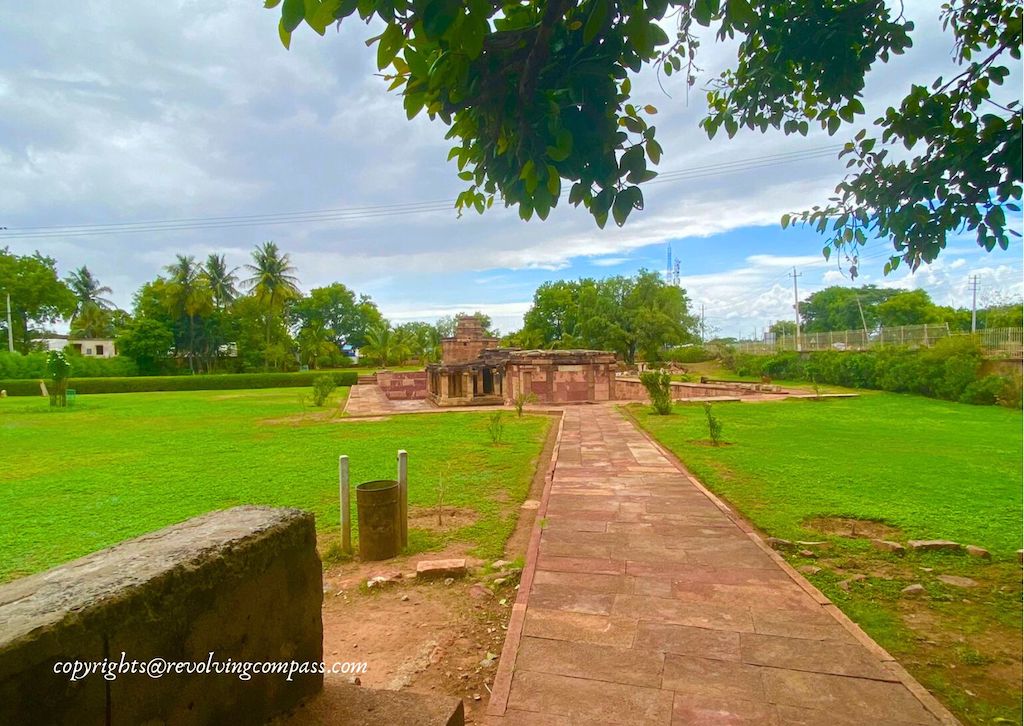
Jyotirlinga Group of Temples
The Jyotirlinga group of Temples is another major temple complex in Aihole. It has around 16 temples. Like the other temples in the complex of Hampi, Badami, Pattadakal and Aihole, most of these temples are also dedicated to Lord Shiva and a step well.
Ramalinga Group of Temples
This is one of the most famous group of temples in Aihole. As , the Ramalinga Group of temples hosts the annual car festival in Aihole. The main temple in this complex is the Trikutachala style Ramalingeshwara Temple. This temple has shrines of Shiva and one of Parvati as well. This temple has two has two Kadambanagara towers. It was perhaps built around the 11th century.
Charanti Math Complex
The Charanti Math Complex in Aihole consists of a Jain Temple. The temple is built in a very similar style as most of the other Jain Temples of India. So, it must have served as a prototype for many of them. However, I could not gather much information about this temple complex from our guide.
Meguti Jain Temples
The Meguti Jain Temple is located inside the Aihole fort complex. Currently, the Meguti Jain Temple is the only dated temple in Aihole. Like most of the other Jain Temples that I have so far visited in India, the Meguti Jain Temple consists of almost two different levels. The first level has an empty chamber. And a flight of stairs that lead to the second level. Where one can see Jain teerthankaras established. Although, the construction of this temple appears to be incomplete. From the main road, one can reach to this temple through Mallikarjuna Temple Complex.
Kunti Temple Complex
Built between the 6th and 8th century, the Kunti Temple Complex is located almost in the centre of the Aihole village. And thus, it is not very easily visible from the main road. The temples here have carved images of Shiva, Vishnu and Brahma on the ceiling. While one of the temple faces east, the other two temples in this complex face west. And they are also interconnected through a common portico, something similar that I observed among two of the temples while visiting the Khajuraho Temple Complex.
Ravanaphadi Cave Temple Complex
The Ravanaphadi Cave is a 6th-century rock-cut Aihole Cave Temples housing Shiva and Parvathi. It is located around 1km from the main Durga Temple Complex. This temple complex has extensive artwork featuring Lord Shiva, Parvathi, Ganesha and Vishnu. It is considered as the prototype to the Cave Temples of Badami. And the first of its kind cave temple in India.
Mallikarjuna Group of Temples
The Mallikarjuna Group of Temples are yet another shrines of Lord Shiva and have the Dravidian style of architecture.
Huchimalli Temple Complex
This is a group of 4 temples of the Chalukya period. These temples contain the shrine of Shiva. And are built around the 4th – 6th century. The shrines here have very beautiful carvings all over them representing some pictures from Puranas.
Galaganatha Group of temples
Almost on the banks of the river Mahaprabha lies the Galaganatha Group of temples. It is a fairly large temple complex that consists of 38 shrines. Unfortunately, many of these shrines are lost to ruins now. But the main Galagnatha temple still stands in the complex. Most of the temples built in the Galaganatha Temple Complex are from the 8th century.
Rachi Temple
A trikutachala Shiva Temple, Rachi Gudi or Rachi Temple is built around the 11th century. The architecture of this temple reminded me of that of the Brihadeeshwara Temple main shrine in Thanjavur. There are smaller shrines of Ganapathi, Natraj and Vishnu around the main shrine of the temple.
Chikki Temple
Situated close to the Durga Temple Complex, the Chikki Temple complex is relatively smaller. The main temple faces east. Two of the temples in this complex resemble the Chalukyan temple architecture. While the third one is built as an open shrine.
Hucchappayya Temple Complex
Another genius architecture in the cradle of Indian Temple architecture at Aihole is the Hucchappayya Temple Complex. Although I couldn’t gather much information about this one.
How to plan a trip to the cradle of Indian Temple Architecture at Aihole
Aihole is a small village. It is mostly visited as a part of the Badami Circuit (A trip to Badami, Pattadakal and Aihole together). In this trip you can comfortably cover the Temples of Aihole, The monuments of Pattadakal and the famous cave temples of Badami and Bhootnath Group of Temples in Badami. You can dedicate a day each to explore places to see in Badami, Pattadakal Temple Complex and Aihole. While staying in Badami as your base. The road connectivity from Badami to Aihole is very good. We planned our 4 days trip to Badami, Pattadakal and Aihole together this year.
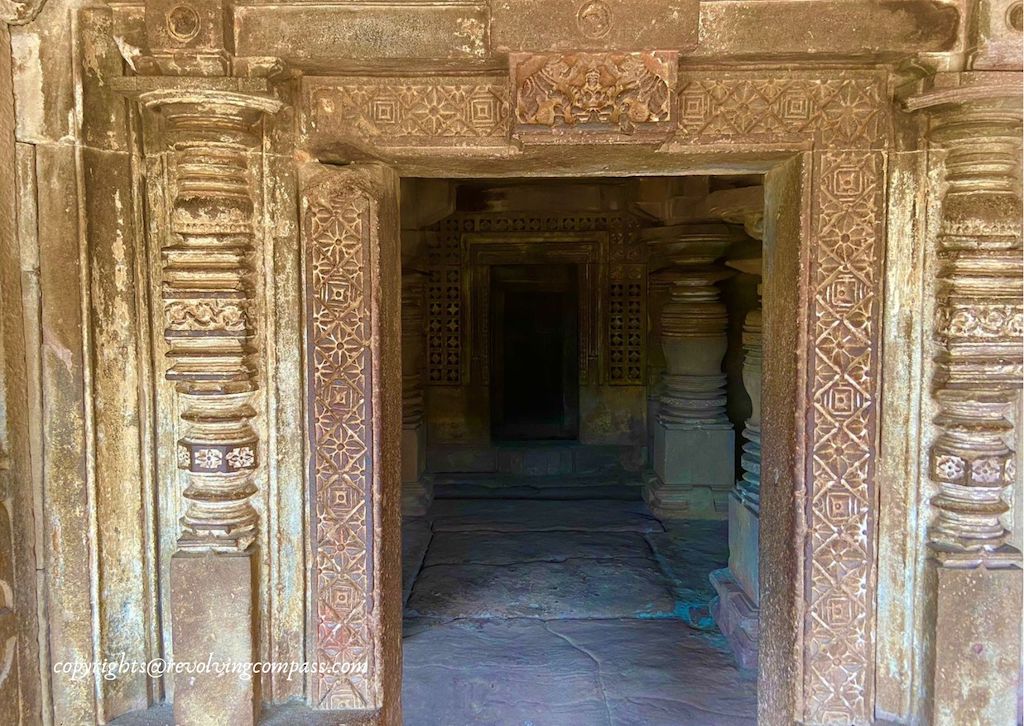
Many cover Aihole, Pattadakal and Badami along with their trip to Hampi. We also wanted to do the same. A 5 days trip to Hampi, Badami, Pattadakal, Aihole is perfect to cover all these places. But, somehow, that trip never materialised for us. Interestingly, we even booked our hotels a couple of times. And then had to cancel the same. Because of various reasons which we couldn’t foresee. Like a lockdown once, and our kids exams the second time. Finally, it is a story in itself how this trip materialised. While we were planning for a coastal Karnataka trip end of June. But then the coastal region got overcast and it looked like we were going to encounter heavy rains all through that weekend in that region. Finally, we gave up on coastal Karnataka. And then materialised our impromptus trip to to Badami, Pattadakal and Aihole !!
There is a KSTDC operated hotel Mayura in Aihole, almost 500 meters from the main Durga Temple Complex. It provides for lodging as well as a decent restaurant for lunch. So, if you want to stay overnight at Aihole, then it’s your best bet.
How to reach Aihole
Aihole is well connected with Badami and Hampi by roadways. Here are some of the ways you can explore Aihole :
By Road
- Drive from Hampi or Hospete to Aihole ~ 3 hours
- Drive from Hubli to Aihole ~3 hours
Both of the above – Hubli and Hampi – have very good accommodation options.
- Drive from Badami to Aihole. ~ 40 mins
This is the best option. You can dedicate one day to exploring Aihole while staying base in Badami. There are quiet a few decent accommodation options in Badami as well now.
We went by the third option as well.
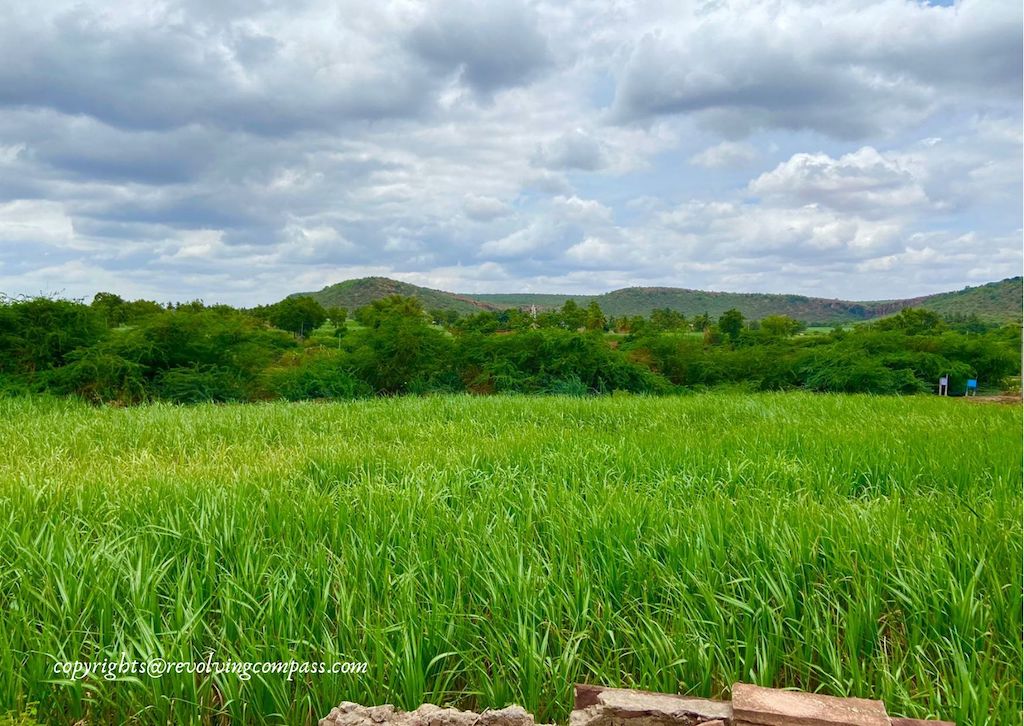
Either you can drive in your own vehicle from Badami to Aihole. Or, you can easily hire a taxi or an auto from Badami. Buses also ply between Badami and Aihole.
There are two most convenient ways to reach Badami –
- By Overnight train from Bangalore
- Driving on your own
We drove from Bangalore to Badami. It was around 11 hours drive including breaks. I will dedicate a separate post to this drive with all the details.
By Train
However, you can as well travel from Bangalore to Badami via an overnight train. As Badami is also the nearest train station to Aihole. Since, the train is overnight, you will save on the daytime driving between places.
By Air
The nearest airport is Belgaum. And next one Hubli at 2.5 hrs driving distance from Badami. So, you can conveniently land via air from any part of India. And then take a taxi or a bus to reach Aihole or Badami. In fact, Badami is very centrally located from Pune, Sangli and other prominent towns in Maharashtra, at a couple of driving hours distance from Goa, at just 2 hours ride from Hubli and many other places. And it is well connected via both rail and road to all these places. So, many even cover Badami while on their way to Goa or while exploring Hampi.
What is the best time to visit Aihole
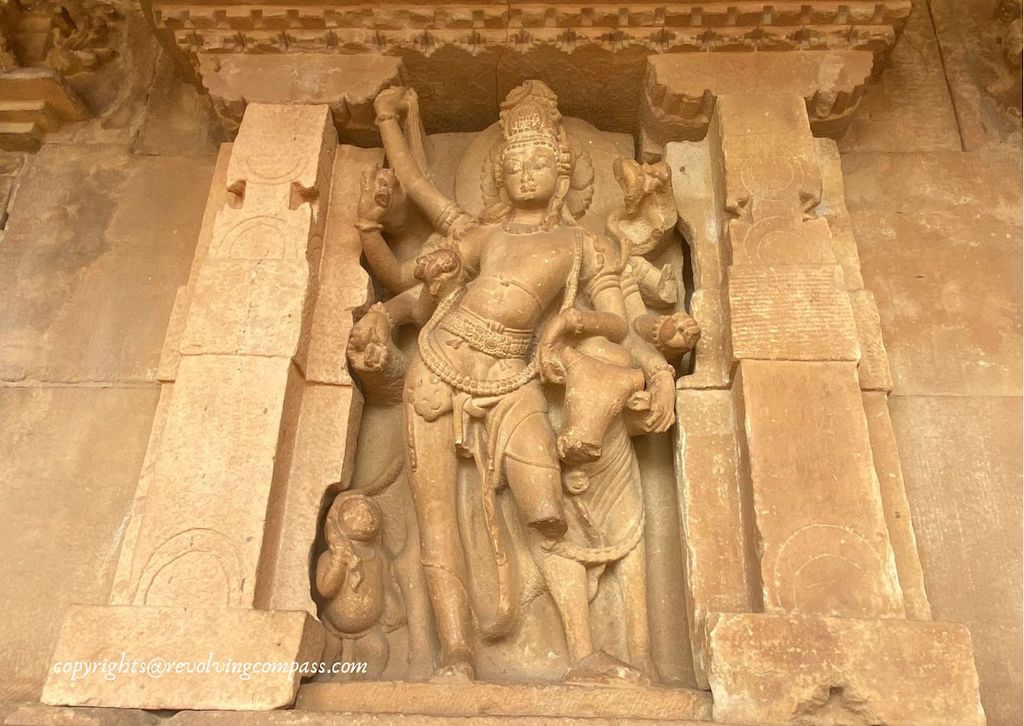
The hills around Aihole are part arid and covered in red sandstones. And the weather is mostly hot all through the year. But the day temperature is still bearable in the months of November through February. So, this marks the best time to visit Aihole. Although, you can also visit here at the beginning of the monsoon months. When the showers are not very strong but the sky is overcast. Given there is hardly any shade and you will be exploring most of the places in Aihole in daytime enduring the sun, a cloudy day will make for a perfect comfortable time to explore around. But you have to be lucky to find a cloudy but not rainy day, just like we did on our trip to Chitradurga Fort and around.
We also made our trip to Badami, Pattadakal and Aihole at the onset of monsoons in Karnataka.
Where to stay in and around Aihole
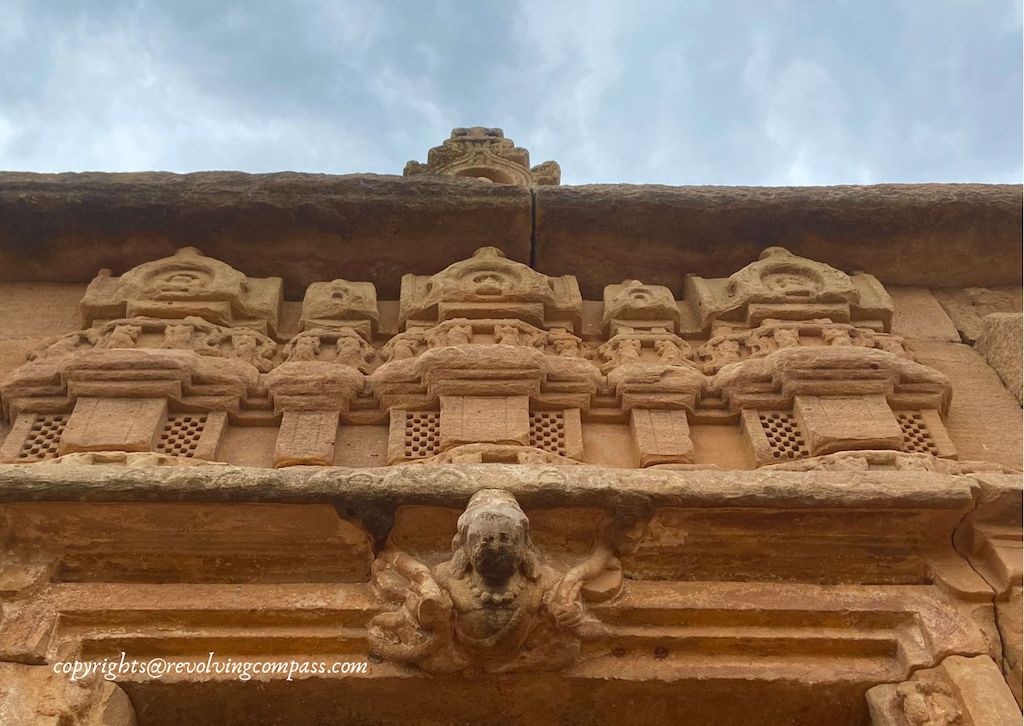
There are not any stay options in Aihole except KSTDC Hotel Mayura
You can either stay at Badami. It is at just 1.5 hours driving distance from Aihole. And anyways, your trip to Aihole will include exploring nearby Badami cave temples and Pattadakal monuments. Here’s a list of hotels at Badami to explore. We were eyeing the Badami Court Hotel and our stay, but couldn’t secure. Later we booked the Badami Heritage Resort. Our stay was decent enough.
If you prefer more comfortable or luxurious stays, then Hampi is another option. The town of Hoskote and the Vijayanagara Empire ruins of Hampi are surrounded by several homestays as well as luxury resorts. You can browse the list here. On our first trip to Hampi, we stayed at Royal Orchid Hampi. And had a great time. A homestay with very strong ratings is Arjun Homestay – a very comfortable stay again. And there are several budget options also.
Last but not the least, you can get basic rooms in Aihole as well for overnight stay. But it might not be as convenient for families as for solo traveler or group of friends.
General tips on visiting the cradle of Indian Temple Architecture at Aihole
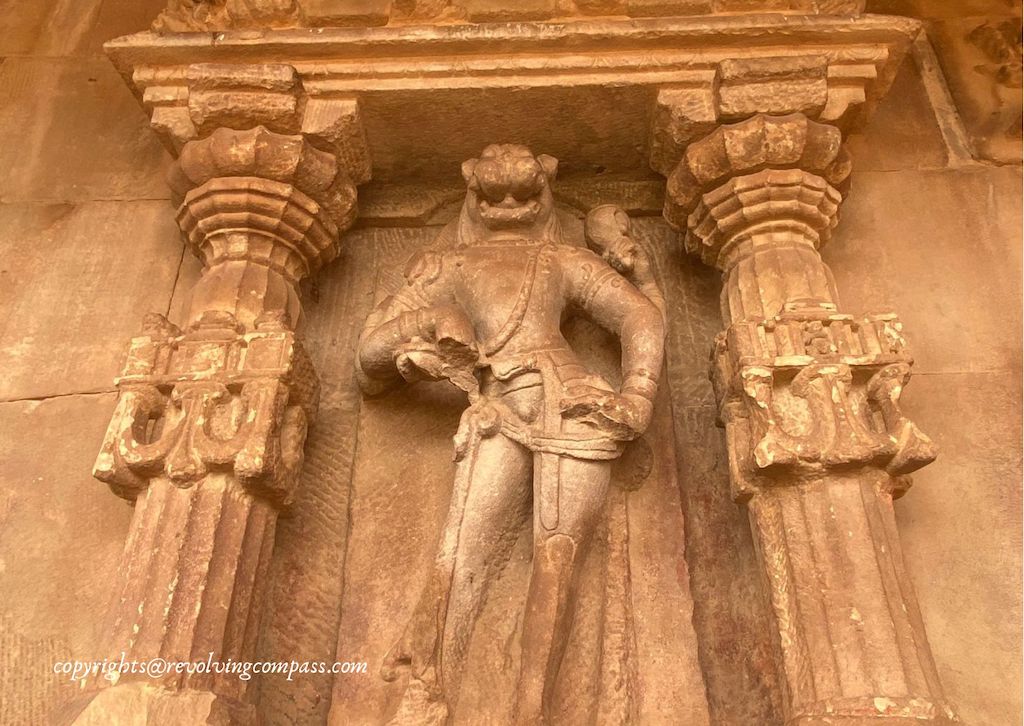
- Wear comfortable cotton cloths and comfortable walking shoes
- All monuments here are open from 10:00am to 5:00pm.
- Mostly the tour itineraries only cover Durga Temple Complex, you can visit the rest on your own.
- If you can, you should dedicate an entire day to the temple complexes of Aihole, admiring the cradle of Indian Temple Architecture at Aihole.
- Durga Temple Complex is the only one requiring an entry ticket. It is a nominal ticket of INR 20/0 per Indian and 205 for foreigners. And additional charge of INR 25 is levied on cameras.
- There is only a few local dhaba style restaurants in Aihole. Best will be to pack and carry your lunch from Badami or Hampi.
- Carry drinking water as well with you.
- There is restroom available in the Durga Temple Complex
- It will really help to hire a guide here, to understand the significance of each temple in depth.
- Carry an umbrella particularly when visiting in either very sunny or cloudy season.
PS: Some of our links are affiliated, this means we will earn a commission when you buy a service or product by clicking those links. However, this will have no extra cost for you.